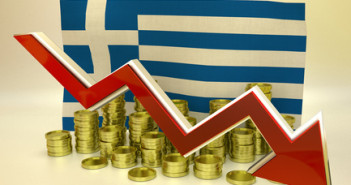The potential for money printers to begin churning out Drachma notes as Greece stumbles closer to the brink of bankruptcy and the exit of the European Union has risen slightly higher given the breakdown in talks over the weekend. The gap between the two negotiating sides appears it may be too wide to bridge before the end of the month given the talks were ceased after only 45 minutes, with Greece still refusing to budge on both pension cuts or VAT increases. Though the repudiation of Greece to consider pension reform or increasing their VAT makes it seem as if a deal will be impossible to broker by the European finance minister meeting on the 18th of June, reports indicate that revenue gap between what the Trokia is pushing for, and what Syriza refuses to budge on, is only about €2bln per year. Putting the government revenue gap into context suggests the sides aren’t as far away as has been telegraphed by the unproductive negotiations, and will likely give the core countries greater incentive to reach a deal as a full default will end up costing Germany and France much more. The euro has started out the new trading week against the greenback under renewed selling pressure, though the common-currency has managed to cauterize some of the early bleeding and has limited its initial losses. All eyes will be on the negotiation process ahead of the finance minister meeting this Thursday, though given the lack of progression thus far, it is hard to see a grand bargain reached in a few days.
As a result of the euro witnessing a strong offer tone this morning, the DXY has pushed higher ahead of the opening bell in North America. The big event risk as related to the dollar-linked index over the coming week will be the two-day policy meeting of the FOMC, as we will get both a press conference and an updated summary of economic projections. While expectations for when the first step towards monetary tightening will take place have been pushed back from June to September, the way the Fed telegraphs the path forward will be key toWednesday’s conclusion of the two-day meeting. We will likely see the Fed revise full-year growth forecasts lower due to the deeper than anticipated weakness in the first quarter, while at the same time reassuring market participants economic activity is picking up again. Since the Fed appears to like to refrain from dealing in certainties and would rather stay more nimble with it’s “data dependent†state, we would anticipate the Fed will keep the likelihood of a rate hike later this year on the table, yet abstain from painting themselves into a corner by outlining a “date dependent†time frame. Make sure to speak to your dealing teams leading into Wednesday’sconclusion, as the associated statement and press conference will likely give rise to volatile trading conditions as participants adjust their expectations for whether the first rate hike will be in September or December.
US equity futures have followed the path of global equities and look to set to open sharply lower when the opening bell rings. The hydrocarbon complex has also witnessed a bit of weakness to begin the week, with front-month WTI trading below $59 as oversupply issues once again exert selling pressure in the asset space. The loonie is slightly weaker against the big dollar from where trading closed on Friday, taking a slight hit as commodities come under pressure and Manufacturing Sales for the month of April fell for the third time in four months. The slide of 2.1% was larger than anticipated by economists, and now stand 7.3% lower than the post-recession peak registered in almost one year ago.
Further reading:
The Fed and USD – All you need to know – MM #54
EUR/USD: Trading The German ZEW Economic Sentiment



